Having the right helm seat can make the difference between a comfortable or uncomfortable trip, be it in a 35m cruiser or a 6m trailer boat. David Palmer looks at some of the options.
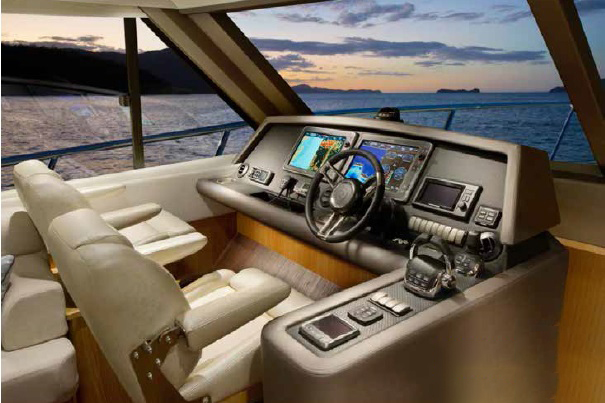
THE DAYS OF using a converted seat from a luxury 4WD for your helm chair have long gone. Today’s helm seats are a science in themselves, an art form in technology and aesthetics, rivalled only by the very latest in first-class airline seats. No longer are they just a place to sit. They are a command station, a place where you can control the boat’s every motion and do it in the ultimate of comfort.
Fighter pilots used to have a theory regarding UK and US aircraft design philosophies. British aircraft manufacturers, they said, would design the loveliest, most streamlined fighter plane you could imagine. Then remember the thing needed a pilot, and cut a hole in it hardly big enough to fit a midget, fit a bent girder for a seat, and call this the cockpit. US manufacturers, on the other hand, would start by designing an armchair, with cushions, recliner mechanism and space enough for a Chicago Bulls player to stretch his legs . . . then design the fighter plane around it.
The UK fighter design philosophy lives on among boat owners, say some of the suppliers of helm chairs. Or does it? It used to be that the helm chair was the last thing a lot of boat owners wanted to spend money on, but to some degree that has changed. While production boat builders tend to offer a more basic, yet still highly functional chair, some custom boat builders have found discerning owners are prepared to pay a little extra for a more technical chair. Unfortunately, the selection of helm chairs for a boat is often left to the last minute after the budget has been blown, so the cheapest option is selected.
When buying a car, one of the first things we often do is try it on for size by sitting in the driver’s seat. Yet how many of us buy a boat without really looking long and hard at the helm seat and it’s not until you are driving out of the marina that you discover you don’t like the helm seat. You and your helm seat are going to have a close relationship. So you’d better make sure you fit together. Any boat from about 10m upwards should have a purpose designed helm seat on it for safety, comfort and good looks.
When installing the helm seat there is often limited room and the last place to be given serious thought, and often a helm seat is installed with little or no thought given to comfort, seat recline, leg support or seat adjustment. A helm seat is often installed because it fits. The value of having the right seat is paramount for both comfort and style.
STRESS & STRAIN
A lounge chair or car seat will cope with a well-nourished 120kg without any problem, but they aren’t subject to the kind of pitching and rolling movements, and hence accelerations, which a helm chair is.
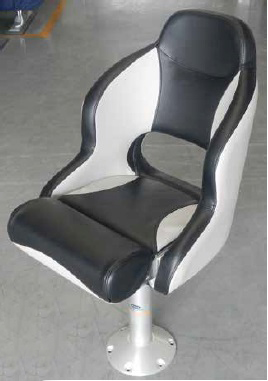
There are chairs and pedestals made for trailer boats and those made for bigger boats. There are big differences in cost, construction and function and some good reasons why these differences exist. For this reason, it is important not to use a trailer boat seat on any flybridge cruiser or bigger boat. Interestingly, the higher above the water, the more stress placed on the chair. This is because the acceleration that a helm chair is subjected to in a superyacht can be far greater than that on your average small cruiser, when the vessels are having accelerations forced on them by wave action.
A pitching boat is a bit like a seesaw. On a small boat, the helm chair will be close to the waterline, probably quite central, and so not far from the pivot point. But on a big planing motor yacht the flybridge will be three metres or more above the pivot point; furthermore, the helm chair will likely be raised further from its pedestal than on small boats since the skippers of larger vessels need to sit higher to see over the bow. So when that big boat starts pitching, the helm chair will be hurled to and fro across a considerable arc. If a 120kg body is sitting on it, the stresses on the chair and its pedestal will be prodigious. Likewise, when a large yacht heels, the helm chair gets swung across a larger lateral arc than for a small sailboat.
It obviously makes sense to have a helm chair that is comfortable, but the unique motion characteristics of different boats – and of all boats as opposed to houses, trucks and cars – takes user comfort beyond mere convenience to a serious operational issue. Comfort, in fact, is a part of safety.
A helm chair has to hold you in a good posture, or you could end up with back problems after years of being banged around. Your helm chair also needs to be tight fitting. If you haven’t got armrests, or the chair doesn’t hold you firmly, your body will be subjected to even greater inertia forces as you are tossed about in your chair as you fight to stay seated. Boat seats don’t have seat belts to hold you in, so the support needs to be designed into the whole chair and foams concept, creating comfort and support.
A strong purpose-built helm chair is essential for big, fast, boats. Everyone aboard needs to be seated when you’re going full speed. These boats give a smooth ride – until you chop the throttle. The deceleration forces will not only threaten to bowl over anyone standing, but will put serious stresses on the chairs.”
The moulded plastic chairs or converted vehicle seats that may be adequate for small boats aren’t designed to handle these forces. And even if they do survive the stresses of large boat cruising, there’s no guarantee your back will survive the stresses of using them..
If you’re in the market for a helm chair, the following are key factors to consider.
THE HELM SEAT PEDESTAL
The helm chair and its pedestal are two separate components. You can purchase them together as a unit from one manufacturer, or because the interfaces between them come in standard sizes, you can mix and match chairs and pedestals from different suppliers.
Be aware that there is a big difference between pedestals made for trailer boats and those made for flybridge cruisers and big yachts. In particular, aluminium pedestals made for these two markets vary considerably in strength, function, design, corrosion resistance, and cosmetics and, of course, price. Some chairs have a completely integral pedestal with hidden structure, colour matched to the chair covering.
The first point to consider about separate pedestals – and also external chair frames – is whether you want them in stainless steel or aluminium. Each material has one obvious advantage. The mirror finish of stainless steel looks very fine on the bridge, but it comes at a cost: a luxury helm chair made of aluminium can be less expensive. Also, some décor designs require the colour of good quality anodised aluminium.
But there are other fewer obvious factors to take into account. Aluminium is not as corrosion resistant as stainless steel, however if the pedestal is constructed of highquality aluminium and it is inside your boat, then it may not be an issue. Also because it is a softer metal, aluminium swivels can get sloppy with wear and tear over time. However, in hardware properly made, with nylon bushes typically used between the two opposing metals, this problem can be almost eliminated.
The main advantage stainless steel has, is the style and it should be stronger. However be warned there is some very poor quality stainless on the market that may look good, but lacks the right qualities of a quality stainless product. If you’re going to spend an extra million dollars on a good looking boat, you might as well spend an extra thousand dollars and get a shiny chair to go with it.
Whatever the relative merits of stainless steel and aluminium intended for marine use, corrosion will inevitably be a factor in any metal chair designed for use on land that gets transplanted to a boat.
A common feature now is gas-filled pedestals. There are two types. The springy-bouncy that are generally only for trailer boats and the gas assisted – where the gas stay acts to assist adjustment of the chair to the right height and is then locked off solid. A pedestal just bolts the chair to the deck, but there are different kinds of pedestals to suit different options. Pedestals can be made higher to elevate the chair, or with a longer floor plate for added strength. Pedestals can also be adapted to fit electric floor sliders that range up to 1,600mm long; an option typically used to shift a helm chair between a control station and social environment.
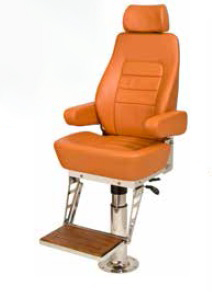
THE HELM CHAIR
Snugness is a big issue here: first in the sense that the chair needs to be a snug fit for whoever is using it; and second because it may have to fit a snug space. One of the key things in a helm chair is the slider, more so than the elevation since you’re likely to use it more often. The slider moves the chair forward or back on its pedestal, the usual maximum distance being between 100 and 250mm. A lot of skippers prefer to stand when docking or in rough weather, and you need a slider or fold-up chair to do that.
The slider is also useful for access, especially on cramped lower bridges when docking big boats. The typical swinging room for a big helm chair is 815mm, and for some workstations you need a slider to be able to swing the chair around so you can sit in it.
A footrest is an essential accessory for a chair mounted on an elevated pedestal unless you want your lower legs dangling like a baby’s on a high chair. Here you have the option of the footrest attached to the chair or the pedestal. Make sure your swivel chair is lockable. Otherwise the boat will turn one way, the chair will swing the other, and you’ll risk a wrenched spine as you twist to stay on the controls just as the boat rams into a wave.
The sliding system is crucial to give the ability to sit comfortably in the steering position and can slide far enough back to stand comfortably at the helm.
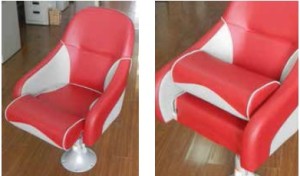
Another type of seat – the folding bolster seat, can give one step better access than a slider. This is a seat on which the front half of the seat cushion folds up and creates an access space or a bolster that a skipper can stand and lean against for stability.
Most of the helm chair developments in recent years have involved the contours and plushness of the chair.You can adjust the tilts and angles of incidence of the seat cushion, backrest and headrest. Some seat backs now have horizontal rows of bolsters with different degrees of compressibility to suit the different parts of your back.
You can get helm chairs with lumbar support, electric heating, cooling and a vibrator that works at different speeds for different parts of your body. As more and more people are doing long distance cruising, you need a seat that you will be able to sit in for long periods and still feel refreshed at the end of a journey. It is important that you are held in tight and feel relaxed. If you need to tighten your abs to sit properly, then it is the wrong seat. The fabric choice is also important as this is where you will spend most of your time.
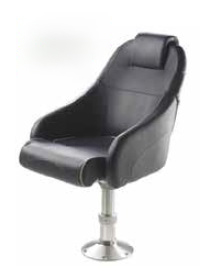
You need to make sure that the fabric is long lasting and can breathe. The worst thing in the world is arriving in port all hot and flustered because you have been sweating in a seat for the past 24 hours. Always try and get something that not only feels great, but can also breathe. A lot of people were putting on real leather, but more and more people are now moving towards Ultraleather as it is built for the harsh marine environment, is longer lasting, a lot easier to clean and keep clean, breathes, and does not get hot like a lot of other materials. The worst thing is getting back into a hot seat after a day out on the boat.
HELM SEAT PRICING
Cost is another important factor. Just because it is the cheapest or most expensive seat on the market doesn’t mean that it is right for you. Helm chairs vary in price considerably – it just depends on what you want. $3-5,000 will get you a good one that won’t look out of place on any boat. $12-25,000 will get you an all-electric chair with enough style to be an adornment to any super yacht and enough features to make any skipper happy in his work.
And if you really want to go for the ultimate in helm seats and you have a spare $25k to $40k to spend, a custom made helm chair that will put the boat controls at your fingertips, mounted in the armrests is available. This even includes a toggle for steering. These aren’t common, though, perhaps because most boaters are romantic enough to picture themselves standing manfully at a helm. While in some cases you may find yourself paying more for a prestigious name than for features, a good quality helm chair is not just an aesthetic asset, but also an important safety feature and an integral aspect of controlling the boat. Ultimately, you need to be comfortable and that’s where the right choice of seat is so important.




